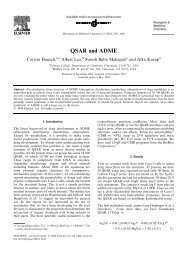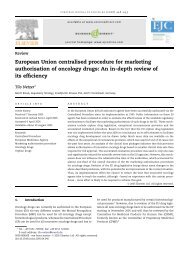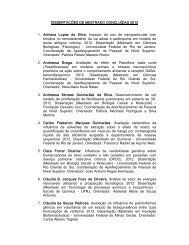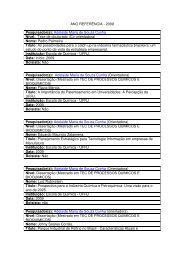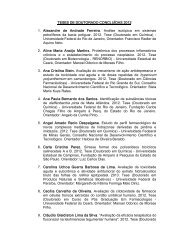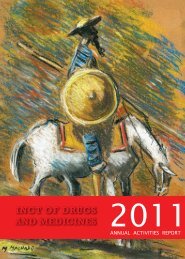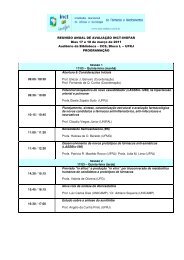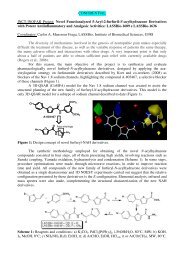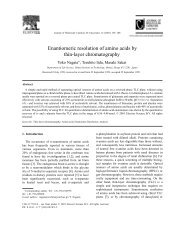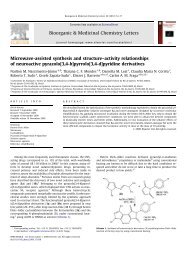View - ResearchGate
View - ResearchGate
View - ResearchGate
- No tags were found...
Create successful ePaper yourself
Turn your PDF publications into a flip-book with our unique Google optimized e-Paper software.
4346 Journal of Medicinal Chemistry, 2004, Vol. 47, No. 18 Perspectivealso be used for relatively large-scale generation ofmetabolites. Tissue slices such as liver slices containboth phase I and II drug metabolizing enzymes and canbe used to generate sufficient quantities of metabolites.51Cell Lines Containing HeterologouslyExpressed Drug-Metabolizing EnzymesRecently, several cellular systems that express highlevels of CYP enzyme have been used as “CYP bioreactors”for rapid and large-scale biosynthesis of metabolites.These include baculovirus-infected insect cells, 52immortalized human liver epithelial cells, 53 and E.coli 54,55 that have been engineered to express largequantities of individual CYP enzymes. These CYPbioreactor systems are capable of generating appreciablequantities of CYP-derived metabolites using simpleequipment. Although CYP bioreactors are still at anearly development stage, it has been demonstrated thatthey are a promising technology for large-scale and lowcostproduction of metabolites. Currently tested CYPbioreactors, such as suspension cultures of insect cellsand attachment cultures of immortalized human celllines, have several unique advantages over conventionalmetabolism systems and chemical synthetic approaches.These include rapid and stereospecific synthesis ofhuman CYP-derived metabolites at very high yield andease of metabolite isolation and identification, as bioreactormediums are relatively clean compared to otherbiological fluids.As discussed above, the microsomal fractions (Supersomes)prepared from baculovirus-insect cell systemshave wide applications in in vitro metabolism studies.In addition, suspension cultures of the baculovirusinsectcell systems were developed as CYP bioreactorsfor biosynthesis of milligram quantities of metabolitesat minimal cost. 52 Metabolite production by the insectcell CYP bioreactor consists of three steps: (1) growthand maintenance of insect cells in suspension cultureuntil a desired cell density is reached, (2) transfectionof the insect cells with baculovirus containing cDNA fora CYP enzyme and/or CYPOR, and (3) metaboliteproduction by the addition of the parent drug to thesuspension culture. High metabolite yield is achievedusing this system. For example, metabolite yields fortestosterone, diazepam, and diclofenac in the appropriateinsect cell CYP bioreactors were more than 85% ata 100 µM substrate concentration. 52Immortalized human liver cell lines transfected withindividual human CYP genes were originally developedfor identifying potential mutagens, cytotoxins, andchemotherapeutics agents. 56,57 More recently, the systemhas been applied for the biosynthesis of milligramquantities of CYP-dependent metabolites. 35,53 Studieswith several CYP substrates in the immortalized humancell CYP reactors showed 75-100% conversions after2-3 days of incubation. 53 The immortalized human cellCYP bioreactor system is particularly suitable formetabolite production from compounds that show intermediateto high rates of metabolism. Briefly, typicalbiosynthetic reactions were initiated by transferringdrugs into a flask after the cell lines have formed amonolayer. Incubations were carried out in a serumfreemedium at 37 °C for 2-3 days. By use of this procedure,the biotransformation of testosterone using aCYP3A4 bioreactor was recently explored, resulting inthe formation of 6β-OH testosterone with greater than90% yield. 53 These systems are relatively clean, and themetabolites in the incubation media can be directlyidentified by LC/MS or LC/NMR with no further purification.Microbial Cell-Based SystemsCYP-dependent monooxygenases capable of carryingout the oxidative biotransformations of xenobiotics havebeen found in bacteria, yeast, and fungi. 58 Usually, thefungal systems are two-component microsomal systemssimilar to liver monooxygenases, and the bacterialsystems are soluble three-component systems similarto the adrenal mitochondrial monooxygenases. 58 Althoughphase I metabolism is of more importance foridentifying metabolites with pharmacological and toxiceffects, some microbial phase II enzymes have beendescribed, including glucuronosyltransferase, arylsulfotransferase,and glutathione S-transferase. 59-61 Smithand Rosazza first proposed in 1974 that microbialbiotransformations could be used for the preparation ofmammalian drug metabolites. 62 Once identities of themicrobial and mammalian drug metabolites have beenestablished, usually by LC/MS, the microbial metabolitescan be prepared in sufficient quantity to be usedin biological activity tests, preparation of analyticalstandards, and further elaboration by medicinal chemists.The advantages of using microorganisms for productionof metabolites are that the cultures are relativelyeasy to maintain and grow and that scale-up toproduce milligram or gram amounts is readily accomplished.In some cases, it is not possible to obtainall of the mammalian metabolites by microbial transformationbut because of the simplicity of the methodsand the capability of supplying large amounts of metabolites,the technique remains a useful option.A typical procedure for determining whether a microbialsystem will be useful would begin by screeninga group of bacterial or fungal strains to determine ifthe desired mammalian metabolite is produced. Fungalstrains, especially Cunninghamella elegans, Actinomycetebacterial strains, and Streptomyces griseus, areamong the most useful. In a typical procedure, acollection of strains such as the group listed below isgrown at 28 °C in shake flasks on a medium known tobe favorable for hydroxylations. 62 Nutrisoy is oftenadded because it can induce monooxygenase activity. 63Some fungal strains typically screened in our laboratoriesto obtain hydroxylated metabolites of drug candidatecompounds are Cunninghamella elegans, Aspergillusniger, Aspergillus foetidus, Beauvaria bassiana,Cunninghamella echinulata, and Aspergillus ochraceus.Actinomycete strains typically screened are Streptomycesgriseus, Saccharopolyspora hirsuta, Nocardioidesluteus, Amycolatopsis orientalis, Amycolata autotrophica,and Streptomyces antibioticus. For example, aStreptomyces griseus bacterial strain was used recentlyto produce a total of 49 g of (8S)-hydroxymutilin (BMS-303786), 17 g of (7S)-hydroxymutilin (BMS-303789), and13gof(2S)-hydroxymutilin (BMS-303782) from 162 gof mutilin. 64Production of metabolites by many other strains offungi and bacteria has been reported. 65-68 Many ex-



